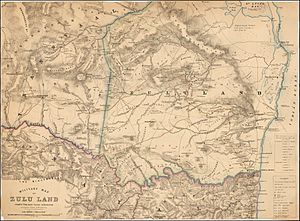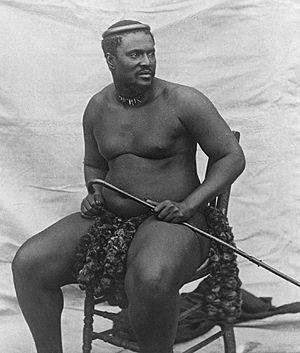Sihayo kaXongo facts for kids

Sihayo kaXongo (born around 1824 – died July 2, 1883) was an important inKosi (chief) of the Zulu. He was also known as Sirhayo or Sirayo in some British records. Sihayo was a commander, called an inDuna, in the iNdabakawombe iButho (a group of men of similar age who also served as soldiers). He strongly supported Cetshwayo during the Zulu Civil War in 1856.
Under King Cetshwayo, Sihayo became a chief in a very important area. This land was right on the border with the British Colony of Natal. He also had a seat on the iBandla, which was the king's royal council. Sihayo was known to like European things; he wore European clothes and was friends with a trader named James Rorke, who lived nearby at Rorke's Drift. By 1864, Sihayo was the leader of the Qungebe tribe. That year, he helped set a new western border for the Zulu kingdom with the Boer leader Marthinus Wessel Pretorius.
In 1878, an event involving Sihayo's family and two women who had fled to Natal caused a big problem. Sihayo's sons and brother crossed the border into Natal to bring the women back. The British government was very upset about this. They demanded that Sihayo's family members be handed over to face British law. King Cetshwayo refused this demand. This incident became a main reason, or casus belli, for the Anglo-Zulu War in 1879. Sihayo's home, called a kraal, was attacked by the British on January 12. One of his sons was killed. Sihayo had already taken most of his men to Ulundi to join the main Zulu army.
Even though the Zulu won a big victory at the Battle of Isandlwana, where some of Sihayo's men fought, they eventually lost the war in July. The Zulu kingdom was then broken up, and Sihayo lost his land. Sihayo was killed in July 1883 when Ulundi was attacked by the forces of Zibhebhu kaMaphitha during another Zulu civil war.
Early Life and Rise to Power

Zulu people in Sihayo's time did not use English-style last names. Instead, they used a system where a person's name showed who their father was. So, Sihayo was the son of a man named Xongo. British documents sometimes called him Sirhayo or Sirayo. We don't know the exact birth years for many Zulu people from this period. However, historians can guess their age by looking at their iButho, which was a group of men born around the same time. This group also served as a military unit. Historian John Laband thinks Sihayo was born around 1824. Sihayo became an inDuna, which means a commander, in the iNdabakawombe iButho.
Sihayo was a strong supporter of Cetshwayo's claim to become the leader of the Zulu Kingdom. He helped Cetshwayo in his fight to become king after his father, King Mpande. Cetshwayo was competing against his brother Mbulazi during the civil war in 1856. The war ended with the Battle of Ndondakusuka on December 2, 1856. In this battle, Cetshwayo's forces defeated Mbulazi and his supporters. After this victory, Cetshwayo took control of the kingdom, even though his father remained the official king until he died in 1872. Sihayo seemed to have a close relationship with Cetshwayo and was part of his iBandla, the royal council.
By 1864, Sihayo was the chief of an important part of the Zulu kingdom's border. This area was next to the British Colony of Natal along the Buffalo River, in the southwest of the kingdom. He built his home, known as a kraal, near Rorke's Drift. This crossing point was named after an Irish trader named Jim Rorke, who lived there and was a friend of Sihayo. Sihayo liked European things and wore European clothes instead of traditional Zulu clothing. He owned two good English-made shotguns and was known to be a skilled hunter.
In 1864, Sihayo was officially made the head of the Qungebe tribe. He was given more land next to what he already had. That same year, he met with the Boer leader Marthinus Wessel Pretorius. They worked together to mark the western border of the kingdom with the South African Republic. This border had not been clearly defined before. The two men built stone piles, called cairns, to show where the new border was.
The Border Incident of 1878

In 1878, a serious event happened involving Sihayo's family. His son Mehlokazulu, along with his uncle Zuluhlenga and three brothers, decided to act against two women. These women had fled to the British territory of Natal.
The women found safety in the homes of two Natal border guards. British authorities usually allowed Zulu people seeking refuge to settle in Natal. However, before 1875, wives who ran away were often sent back to their husbands. In 1877, Zulu men had crossed into Natal to capture a woman, and the British governor of Natal, Henry Ernest Gascoyne Bulwer, had complained to King Cetshwayo. The British themselves often crossed the border to catch people who had fled. Because of this, Mehlokazulu thought there would not be big problems if he crossed the border to bring the women back.
Mehlokazulu and other men from Sihayo's household crossed the border. They seized one of the women, brought her back to Zululand, and she died. A few days later, about eighty of Sihayo's men, led by the five family members, did the same to the other woman. They killed her on the Zulu side of the Buffalo River, in sight of Rorke's Drift. The border guards were not harmed in either incident.
When Governor Bulwer learned about these border crossings, he complained to King Cetshwayo. He demanded that Sihayo's sons and brother be handed over to face justice in Natal. King Cetshwayo believed that the women had broken Zulu law and had not been killed on Natal land. So, he felt there was no reason to hand over his people. Cetshwayo offered to pay a fine of £50, which was probably all the British money he had. But Bulwer refused this offer.
Bulwer was thinking about asking for a fine of 5,000 cattle. However, the British High Commissioner for Southern Africa, Sir Henry Bartle Frere, saw the incident as a major offense. Frere decided it could be a reason, or casus belli, for his long-planned invasion of Zululand. The demand for Sihayo's brother and sons to be handed over was part of Frere's ultimatum to the Zulu in November 1878.
This ultimatum was very harsh. It demanded big changes to the Zulu way of life and social system. Frere intended for King Cetshwayo to reject it. Cetshwayo felt that handing over Sihayo's relatives would weaken his power as king. This was because Sihayo was his personal representative on the Natal border. He also did not want to hand over Mehlokazulu, who was a favorite of the king. Mehlokazulu was also an inDuna in the iNgobamakhosi, the king's favorite iButho. Giving him up would have insulted this important regiment. Some members of the king's iBandla thought he should agree to the British demand. They believed it would calm the British. Sihayo himself was criticized by some iBandla members who blamed him for causing conflict with the British.
The Anglo-Zulu War
The British did not receive a response to their ultimatum. So, on January 11, 1879, British forces, led by Lord Chelmsford, invaded Zululand. This marked the start of the Anglo-Zulu War. Sihayo had been gathering cattle to pay the fine he expected. A large group of these cattle were captured by the British central column, led by Chelmsford, as they crossed into Zululand at Rorke's Drift.
On January 12, Chelmsford sent a force to attack Sihayo's kraal. This was to protect the side of his advancing army and to punish Sihayo for the border incident. Sihayo had already left his kraal to join King Cetshwayo's army at Ulundi. He left about 200–300 warriors under Mkumbikazulu. The British defeated Sihayo's men and burned his kraal. Mkumbikazulu was killed in this battle. The survivors from this fight fled to Sotondose's Drift. There, on January 22, they helped kill British soldiers who were escaping after their defeat at the Battle of Isandlwana.
Sihayo himself seems to have stayed out of direct fighting during the war. However, he and Mehlokazulu went with the army on its march to Isandlwana. Sihayo's scouts were the only mounted (on horseback) troops in the Zulu army. His brother Gamdana decided to surrender to the British. He met with Chelmsford at Isandlwana on January 21, the day before the big British defeat. Sihayo's son Tshekwane was killed by British mounted soldiers from the 80th Regiment of Foot (Staffordshire Volunteers). This happened in late March 1879, after the battles of Hlobane and Khambula. The war ended when Chelmsford defeated the Zulu at the Battle of Ulundi on July 4. Sihayo watched this final battle from a nearby hill.
After the War
In August, right after the war ended, King Cetshwayo's senior chief, Mnyamana kaNgqengelele, took all of Sihayo's cattle. He blamed Sihayo for starting the war. Since cattle were the main source of wealth in the kingdom, Sihayo became very poor. As part of the peace terms, the British divided Zululand into 13 chiefdoms. They also ended the iButho system and sent King Cetshwayo into exile.
The two chiefdoms on the Natal border were given to chiefs who had fought for the British. Hlubi, a Basuto chief, received the western part, and John Robert Dunn, a British settler, received the eastern part. Sihayo's lands fell into Hlubi's chiefdom, specifically under a sub-chief named Faku, who was also Basuto. Faku ordered Sihayo and Mehlokazulu to leave his territory, and Sihayo was left without land.
Sihayo continued to support the royalist uSuthu group. This group wanted King Cetshwayo to return. There was fighting between the uSuthu and the new chiefs. The British realized that dividing the kingdom had not worked well. Cetshwayo was allowed to return, but he was only given authority over nine chiefdoms in the center of Zululand. He was surrounded by lands of pro-British chiefs to the north and a Zulu Reserve Territory (made from Hlubi and Dunn's chiefdoms) to the south. This situation only made the conflict worse, leading to the Third Zulu Civil War in 1883. After this second division of land, Sihayo found refuge in the eastern part of the Zulu Reserve Territory with the remaining Qungebe people. They were then attacked there by Hlubi's Tlokwa people.
The uSuthu group invaded the chiefdom of the pro-British chief Zibhebhu kaMaphitha. However, they were defeated by an attack from Zibhebhu's Mandlakazi forces, who then counter-attacked Ulundi. Sihayo had joined King Cetshwayo at the capital and was there when the Mandlakazi took it in July 1883. He was killed in a hut on July 2, along with about 50 other royalist chiefs and izinDuna. King Cetshwayo later died in exile, and the former kingdom was officially taken over by the British in 1887.


